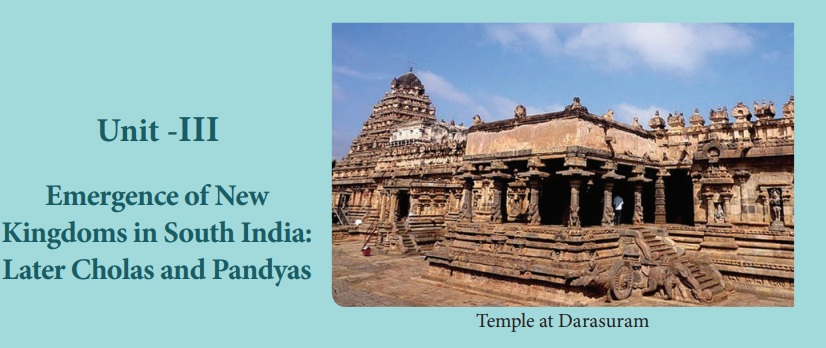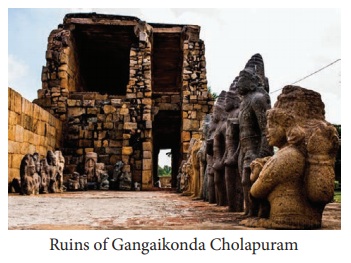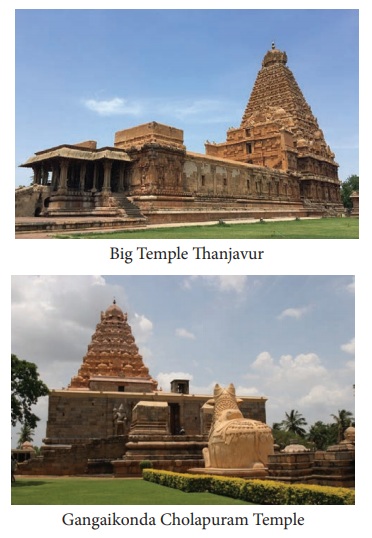Emergence of New Kingdoms in South India | Term 1 Unit 3 | History | 7th Social Science - The Later Cholas | 7th Social Science : History : Term 1 Unit 3 : Emergence of New Kingdoms in South India: Later Cholas and Pandyas
Chapter: 7th Social Science : History : Term 1 Unit 3 : Emergence of New Kingdoms in South India: Later Cholas and Pandyas
The Later Cholas

The Later Cholas
Learning Objectives
•
To trace the origin of the later Cholas and the later Pandyas
•
To know about the prominent rulers of both the kingdoms
•
To acquaint with their administrative system
•
To understand the social, economic and cultural development during their reign
Introduction
The
Cholas are one among the popular and well-known Tamil monarchs in the history
of South India. The elaborate state structure, the extensive irrigation
network, the vast number of temples they built, their great contributions to
art and architecture and their overseas exploits have given them a pre-eminent
position in history.
Revival of the Chola Rule
The
ancient Chola kingdom reigned supreme with the Kaveri delta forming the core
area of its rule and with Uraiyur (present-day Tiruchirappalli) as its
capital. It rose to prominence during the reign of Karikala but
gradually declined under his successors. In the 9th century Vijayalaya, ruling
over a small territory lying north of the Kaveri, revived the Chola Dynasty. He
conquered Thanjavur and made it his capital. Later Rajendra I and his
successors ruled the empire from Gangaikonda Cholapuram, the newly built
capital.
Rajaraja
I (A.D. (CE) 985 - 1016) was the most powerful ruler of Chola empire and also
grew popular beyond his times. He established Chola authority over large parts of
South India. His much-acclaimed naval expeditions led to the expansion of
Cholas into the West Coast and Sri Lanka. He built the famous Rajarajeswaram
(Brihadeshwara) Temple in Thanjavur. His son and successor, Rajendra Chola I
(A.D. (CE) 1016 - 1044, matched his father in his ability to expand the empire. The Chola empire
remained a powerful force in South India during his reign. After his accession
in A.D. (CE) 1023, his striking military expedition was to northern India,
capturing much territory there. He proclaimed himself the Gangaikondan
(conqueror of the Gangai region). The Gangaikonda Cholapuram temple was built
to commemorate his victories in North India. The navy of Rajendra Chola enabled
him to conquer the kingdom of Srivijaya (southern Sumatra). Cholas’ control
over the seas facilitated a flourishing overseas trade.
Decline of the Chola
Empire
Rajendra
Chola’s three successors were not capable rulers. The third successor
Veerarajendra’s son Athirajendra was killed in civil unrest. With his death
ended the Vijayalaya line of Chola rule.

Matrimonial alliances
between the Cholas and the Eastern Chalukyas began during the reign of Rajaraja
I. His daughter Kundavai was married to Chalukya prince Vimaladitya. Their son
was Rajaraja Narendra who married the daughter of Rajendra Chola named
Ammangadevi. Their son was Kulothunga I.
On
hearing the death of Athirajendra, the Eastern Chalukya prince Rajendra
Chalukya seized the Chola throne and began the rule of Chalukya-Chola dynasty
as Kulothunga I. Kulothunga established himself firmly on the Chola throne soon
eliminating all the threats to the Chola Empire. He avoided unnecessary wars
and earned the goodwill of his subjects. But Kulothunga lost the territories in
Ceylon. The Pandya territory also began to slip out of Chola control.
Kanchipuram was lost to the Telugu Cholas. The year 1279 marks the end of Chola
dynasty when King Maravarman Kulasekara Pandyan I defeated the last king
Rajendra Chola III and established the rule of the Pandyas in present-day Tamil
Nadu.
Administration
The
central administration was in the hands of king. As the head of the state, the
king enjoyed enormous powers. The king’s orders were written down in palm
leaves by his officials or inscribed on the temple walls. The kingship was
hereditary in nature. The ruler selected his eldest son as the heir apparent.
He was known as Yuvaraja. The Yuvarajas were appointed as Governors in the
provinces mainly for administrative training.
The
Chola rulers established a well-organised system of administration. The empire,
for administrative convenience, was divided into provinces or mandalams.
Each mandalam was sub-divided into naadus. Within each naadu, there were
many kurrams (groups of villages). The lowest unit was the gramam (village).
Local Governance
Local
administration worked through various bodies such as Urar, Sabhaiyar,
Nagarattar and Nattar. With the expansion of agriculture, numerous peasant
settlements came up on the countryside. They were known as Ur. The Urar, who
were landholders acted as spokesmen in the Ur. Sabhaiyar in Brahman villages
also functioned in carrying out administrative, financial and judicial
functions. Nagarattar administered the settlement of traders. However, skilled
artisans like masons, blacksmiths, goldsmiths, weavers and potters also lived
in Nagaram. Nattar functioned as an assembly of Nadu and decided all the
disputes and issues pertaining to Nadu.
The
assemblies in Ur, Sabha, Nagaram and Nadu worked through various committees.
The committees took care of irrigation, roads, temples, gardens, collection of
revenue and conduct of religious festivals.
Uttiramerur Inscriptions

Uttiramerur presently in Kanchipuram
district was a Brahmadeya village (land grants given to Brahmins). There
is a detailed description of how members were elected to the committees of the
village sabha in the inscriptions found there. One member was to be elected
from each ward. There were 30 wards in total. The eligibility to contest was to
men in the age group of 35–70, well-versed in vedic texts and scriptures, and
also owned land and house. The process of election was as follows: The names of
qualified candidates from each ward were written on the palm-leaf slips and put
into a pot. The eldest of the assembly would engage a boy to pull out one slip
and declare his name. Various committees were decided in this way.
Revenue
The
revenue of the Chola state came mainly from the land. The land tax was known as
Kanikadan. The Chola rulers carried out an elaborate survey of land in order to
fix the government’s share of the land revenue. One-third of produce was
collected as land tax. It was collected mostly in kind. In addition to land
tax, there were taxes on profession and tolls on trade.
Social Structure Based on
Land Relations
The
Chola rulers gifted tax-free lands to royal officials, Brahmins, temples
(devadana villages) and religious institutions. Land granted to Jain
institutions was called pallichchandam. There were also of vellanvagai
land and the holders of this land were called Vellalars. Ulu-kudi, a
sub-section of Vellalar, could not own land but had to cultivate Brahmadeya
and vellanvagai lands. The holders of vellanvagai land retained melvaram
(major share in harvest). The ulu-kudi got kil-varam (lower
share). Adimai (slaves) and panicey-makkal (labourers) occupied
the lowest rung of society. In the intermediate section came the armed men and
traders.
Irrigation
Cholas
gave importance to irrigation. The 16-mile long embankment built by Rajendra
Chola in Gangaikonda Cholapuram is an illustrious example. Vati-vaykkal,
a criss-cross channel, is a traditional type of harnessing rain water in the
Cauvery delta. Vati is a drainage channel and a vaykkal is the
supply channel. The commonly owned village channel was called ur-vaykkal.
The nadu level vaykkal is referred to as nadu-vaykkal. The turn-system
was in practice in distributing the water.
Religion
Chola
rulers were ardent Saivites. Hymns, in praise of the deeds of Lord Siva, were
composed by the Saiva saints, the Nayanmars. NambiyandarNambi codified them,
which came to be known as the Thirumurai.
Temples
The
Chola period witnessed an extensive construction of temples. The temples in
Thanjavur, Gangaikonda Cholapuram and Darasuram are the repository of
architecture, sculpture, paintings and iconography of the Chola art. Temples
during the Chola period were not merely places of worship. They were the
largest landholders. Temples promoted education, and devotional forms of art such
as dance, music and drama. The staff of the temples included temple officials,
dancing girls, musicians, singers, players of musical instruments and the
priests.

Cholas as Patrons of
Learning
Chola
kings were great patrons of learning. Rajendra I established a Vedic college at
Ennayiram (now in Villupuram District). There were 340 students learning the
Vedas, grammar and Upanishads under 14 teachers. This example was later
followed by his successors and as a result two more such colleges had been
founded, at Tirubuvanai near present-day Puducherry and Tirumukkoodal in
present-day Chengalpattu district, in 1048 and 1067 respectively. The great
literary works Periyapuranam and Kamba Ramayanam belong to this
period.
Trade
There was a flourishing trade during the Chola period. Trade was carried out by two guild-like groups: anju-vannattar and mani-gramattar. Anju-vannattar comprised West Asians, Arabs, Jews, Christians and Muslims.
They
were maritime traders and settled on the port towns all along the West Coast.
It is said that mani-gramattar were the traders engaged in inland trade.
In due course, both groups merged under the banner of ai-nutruvar and disai-ayirattu-ai-nutruvar
functioning through the head guild in Ayyavole, Karnataka. This
ai-nutruvar guild operated the maritime trade covering South-East Asian
countries. Through overseas trade with South-East Asian countries elephant
tusks, coral, transparent glass, betel nuts, cardamom, opaque glass, cotton
stuff with coloured silk threads were imported. The items exported from here
were sandalwood, ebony, condiments, precious gems, pepper, oil, paddy, grains
and salt.
Related Topics